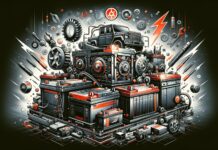The second you put the key in the ignition and turn, hearing the roar of your engine, relay and resistors are hard at work composing the symphony of your vehicle’s intricate electrical systems. The components orchestrate the flow of electrical currents, ensuring every circuit hits its mark and keeps your vehicle humming.
Understanding Relays – Switching Power With Precision
Relays are electromagnetically controlled switches that use a coil to generate a magnetic field that pulls a contact arm, opening or closing the circuits. The action permits a small current to flow through the coil to a much larger current in a secondary circuit.
A typical relay contains several components: a coil, armature, contacts, and yoke. The coil is the primary component, but the armature comprises a piece of metal attracted to the field, producing the necessary action. The contacts are the conducting terminals that open or close the secondary circuit as the armature moves. Finally, the yoke is the metal frame or body that supports the main components.
The most common relay kit and assembly is an electromechanical relay. These devices are traditional and found in most vehicles, especially older models. However, you can also find solid-state relays, which are more modern and are semiconductors that electronically control circuits, offering faster and quieter operation.
Typical applications for relays include motor control, lighting control, security system control, and timer circuit control. You can usually find regulators in systems that operate headlights, fuel pumps, and starters.
Functions and Applications of Resistors
Unlike relays, resistors don’t actively switch circuits. These devices oppose the flow of electricity or resist it. The devices control the current flow through a circuit by varying the resistance level. Some of the most common resistor applications include biasing, current limiting, and voltage dividing.
You can find resistors operating in many automobile electronics. For example, a 2013 Kia Sorento cooling fan relay and resistor devices are present. Also, you can find blower motor resistors and LED load resistors. The devices work to manage current flow and keep your vehicle running properly.
Resistors and Relays Working Together
Relays and resistors work together, achieving complex electrical functions. For example, a headlight relay works to switch on the high beams while the resistor regulates the current to prevent the bulbs from burning out too quickly. While you may not plan on swapping out resistors or relays or performing any electrical work on your vehicle, knowing how the components operate can allow you to appreciate the mechanics and engineering of your car.
Relays and resistors are necessary components of your car’s electrical system. The precise control of the relays and delicate management of resistors ensure your vehicle’s electrical components operate flawlessly. If you find that something electrical is not working as it should, you may have a damaged or faulty relay or resistor. Contact a local mechanic and schedule an appointment to take your car in. The shop can check the system to find any damaged components and easily replace them. You might even try the swap yourself if you are handy and an experienced hobbyist.



































































